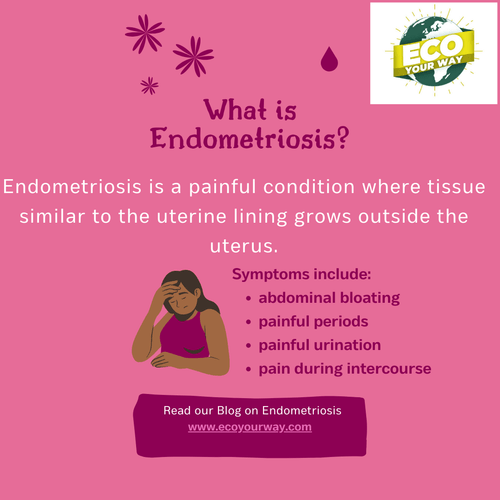Understanding Endometriosis: A Comprehensive Overview
Sep 24th 2024
Endometriosis
Endometriosis is a chronic condition affecting millions of women worldwide. Despite its prevalence, endometriosis is often shrouded in misunderstanding and stigma. This complex disease can significantly impact quality of life, leading to physical discomfort and emotional distress. In this blog post, we'll delve into what endometriosis is, its prevalence, the demographics most affected, methods of diagnosis, holistic care options, and the benefits of using Eco Your Way sanitary pads for those suffering from this condition.
What is Endometriosis?
Endometriosis occurs when tissue similar to the lining of the uterus (the endometrium) grows outside of the uterus, often on the ovaries, fallopian tubes, and other organs within the pelvis. This misplaced tissue can lead to inflammation, pain, and the formation of scar tissue. Symptoms can vary widely; some individuals may experience severe menstrual pain, pain during intercourse, chronic pelvic pain, while others may have minimal symptoms.
Prevalence of Endometriosis
The World Health Organization (WHO) Estimates suggest that endometriosis affects approximately 1 in 10 women of reproductive age, which translates to around 190 million people worldwide. Despite this high prevalence, many remain undiagnosed or misdiagnosed for years. This often leads to unnecessary suffering and emotional distress, highlighting the importance of awareness and education surrounding the condition. To date, there is no known cure for endometriosis. However, there are treatment options available that can effectively control its symptoms.
Demographics Affected
Endometriosis is most commonly diagnosed in women aged 15 through 49, coinciding with their reproductive years. Studies indicate that certain racial and ethnic groups, including those of African, Asian, and Hispanic descent, may be more susceptible to developing endometriosis. Additionally, family history plays a significant role, as those with a close relative who has the condition are at higher risk.
How is Endometriosis Diagnosed?
Diagnosing endometriosis can be challenging due to the variability of symptoms and their overlap with other conditions. Common diagnostic methods include:
Pelvic Exam
A healthcare provider manually examines the pelvic region for abnormalities.
Ultrasound
This imaging technique helps identify cysts related to endometriosis.
MRI
Magnetic resonance imaging provides detailed images of reproductive organs and can help identify endometriosis.
Laparoscopy
This surgical procedure is often considered the gold standard for diagnosis. A surgeon inserts a thin tube with a camera through a small incision in the abdomen to view and possibly biopsy the endometrial-like tissue.
The complexity of endometriosis symptoms often means that a diagnosis can take several years, underscoring the need for greater awareness and understanding of the condition.
Holistic Care for Endometriosis
For many, holistic approaches can complement traditional medical treatments for endometriosis. These methods focus on overall well-being and may include:
Dietary Changes
A diet rich in whole foods, anti-inflammatory ingredients, and low in processed sugars may help alleviate symptoms. Some individuals find relief by incorporating omega-3 fatty acids and reducing dairy intake.
Mindfulness and Stress Management
Practices like yoga, meditation, and deep breathing exercises can help manage stress and improve overall quality of life.
Acupuncture
This traditional Chinese medicine technique has been found to help reduce pain and regulate menstrual cycles.
Herbal Remedies
Some individuals explore herbal supplements, such as turmeric or ginger, which are believed to have anti-inflammatory properties.
Physical Activity
Regular exercise can improve blood flow, reduce stress, and enhance mood, all of which can contribute to symptom relief.
Holistic care emphasizes treating the whole person rather than just the symptoms, and it’s crucial to consult with healthcare professionals before starting any new treatment regimen.
Eco Your Way Sanitary Pads: A Sustainable Option for Endometriosis Sufferers
For those managing endometriosis, choosing the right menstrual products can make a significant difference in comfort and health. Eco Your Way sanitary pads are designed with the needs of sensitive individuals in mind. Made from organic materials, these pads are free from harmful chemicals, fragrances, and plastics, which can irritate sensitive skin and exacerbate symptoms.
Using Eco Your Way Sanitary Pads can offer several benefits for those with endometriosis
Breathability
These pads are designed to allow for better airflow, reducing moisture buildup and irritation.
Chemical-Free
The absence of synthetic materials minimizes exposure to potentially harmful chemicals that could exacerbate symptoms.
Sustainability
Choosing eco-friendly products helps reduce waste and promotes environmental health, aligning with the holistic approach many individuals take in managing their endometriosis.
Comfort
With their soft, gentle materials, Eco Your Way sanitary pads provide comfort during menstruation, which can be particularly important for those experiencing pain.
Conclusion
Endometriosis is a complex and often misunderstood condition that affects many individuals globally. Understanding its prevalence, demographics, and diagnostic methods is crucial in fostering awareness and support. For those suffering from endometriosis, holistic care approaches can complement traditional treatments, and the choice of menstrual products can also play a significant role in managing symptoms. By exploring eco-friendly options like Eco Your Way sanitary pads, individuals can take steps toward greater comfort and well-being while promoting sustainability. Remember, if you or someone you know is struggling with endometriosis, seeking medical advice and support is essential for navigating this challenging condition.

